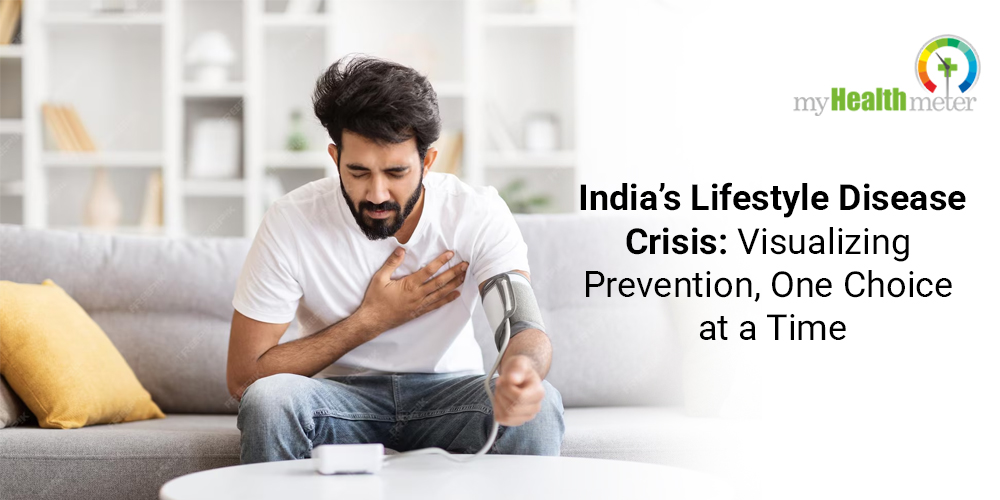India’s Lifestyle Disease Crisis: Visualizing Prevention, One Choice at a Time
-
October 06, 2025
-
201 Views
India’s Lifestyle Disease Crisis: Visualizing Prevention, One Choice at a Time
Picture India in 2025: bustling cityscapes, crowded metros, glowing billboards selling instant snacks, and millions scrolling through their phones while life speeds past. Under these dazzling visuals lies a hidden epidemic—lifestyle diseases silently shaping the nation’s future. Imagine a canvas where every third person has a chronic condition that traces back not to germs, but to daily choices and pressures.
The Numbers: India’s 2025 Health Reality
- Non-communicable diseases (NCDs) now drive over 65% of deaths in India, with cardiovascular disease topping the list at 28% of all fatalities.
- Diabetes remains a key threat, affecting 77 million adults—expected to surge to 134 million by 2045.
- Urban obesity affects 39% of adults; among college students, 28% are overweight/obese, while childhood obesity rates have crossed 14% of school-age children.
- Silent heart risks and fatty liver have reached epidemic proportions: 46% and 65% diagnosed respectively among asymptomatic individuals screening in 2025.
- Hypertension impacts 25% of adults, and 197 million Indians live with mental health disorders.
Modern Triggers: A Changing Landscape
Fast food lines grow longer; physical activity shrinks amid urban congestion. The common culprits leading this epidemic:
- Diets loaded with processed food, sugar, and salt drive up obesity, diabetes, and hypertension.
- Urban jobs and screens contribute to chronic physical inactivity.
- Tobacco and alcohol remain ever-present, fueling cancer and liver diseases.
- Air pollution, in cities like Delhi and Mumbai, directly aggravates respiratory and heart problems.
- High stress, relentless work cycles, and poor sleep escalate risks for depression, anxiety, and heart conditions.
- Hereditary influences, while significant, get amplified by unhealthy choices.
Symptoms: Signs to Watch
Cardiovascular Diseases
- Symptoms: Chest pain, breathlessness, extreme fatigue, irregular heartbeat.
- Harm: Heart attacks, strokes, heart failure with irreversible organ damage.
Diabetes
- Symptoms: Excessive thirst, frequent urination, blurred vision, slow wound healing.
- Harm: Kidney failure, nerve and eye damage, higher risk of heart issues.
Cancer
- Symptoms: Unexplained weight loss, persistent cough, abnormal lumps, bleeding.
- Harm: Organ dysfunction, difficult treatments, lasting side effects.
Chronic Respiratory
- Symptoms: Persistent cough, wheezing, recurrent infections.
- Harm: Severe asthma/COPD, breathing difficulty, decreased everyday function.
Obesity
- Symptoms: High body weight, joint pain, activity intolerance.
- Harm: Increased risk for diabetes, heart disease, cancer, osteoarthritis.
2025 Prevention Pathways: What Works Now
- Nourish Smart: Move towards whole foods—fruits, vegetables, whole grains, healthy proteins. Cut down on packaged snacks and soft drinks.
- Get Moving: At least 150 minutes weekly of moderate activity; every step counts.
- Reduce Substances: Eliminate tobacco, reduce alcohol—prevention wins every time.
- Manage Stress: Mindfulness, yoga, regular sleep, breathing exercises—these are as vital as medication.
- Screen Regularly: Annual check-ups for blood pressure, blood sugar, cholesterol. Early detection is a game-changer.
- Spread Awareness: Use digital platforms and community programs to educate families everywhere.
Routine Health Check-Ups: Your First Line of Defence Against Silent Killers
Routine health check-ups are a game-changer in the fight against lifestyle diseases. These regular screenings act as early warning systems—catching silent threats like diabetes, hypertension, or heart disease before symptoms appear and before complications set in. In 2025, with India’s lifestyle disease rates on the rise, proactive check-ups help millions detect risks when treatments and lifestyle changes are most effective, reducing long-term health costs and avoiding emergency interventions.
Checking in with doctors even when feeling healthy helps spot elevated blood sugar, cholesterol, blood pressure, or markers of obesity and cancer at their earliest stage. This empowers individuals to make informed choices about nutrition, exercise, and stress management, guided by professional advice. Workplace wellness programs and community health camps have made routine check-ups easier to access and more affordable, especially in urban areas and among high-risk groups.
Routine health check-ups do more than prevent illness—they nurture peace of mind, support family wellbeing, and inspire healthier habits for years to come. By catching “silent killers” early and offering targeted guidance, these check-ups are essential for building a future where lifestyle diseases are no longer dominant in India’s health story.





